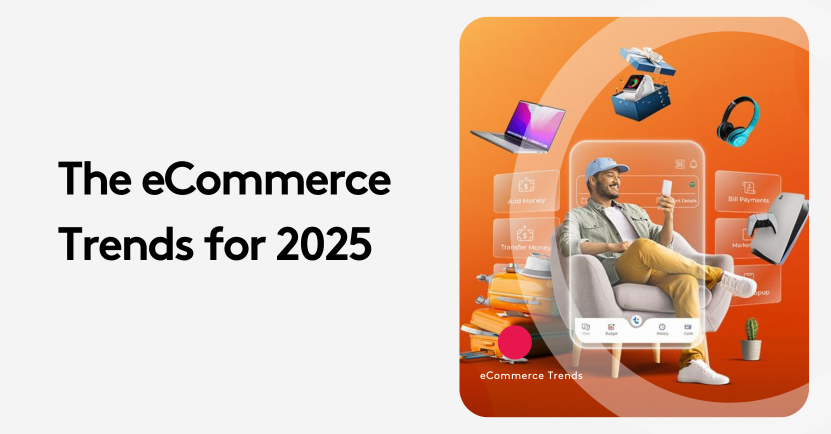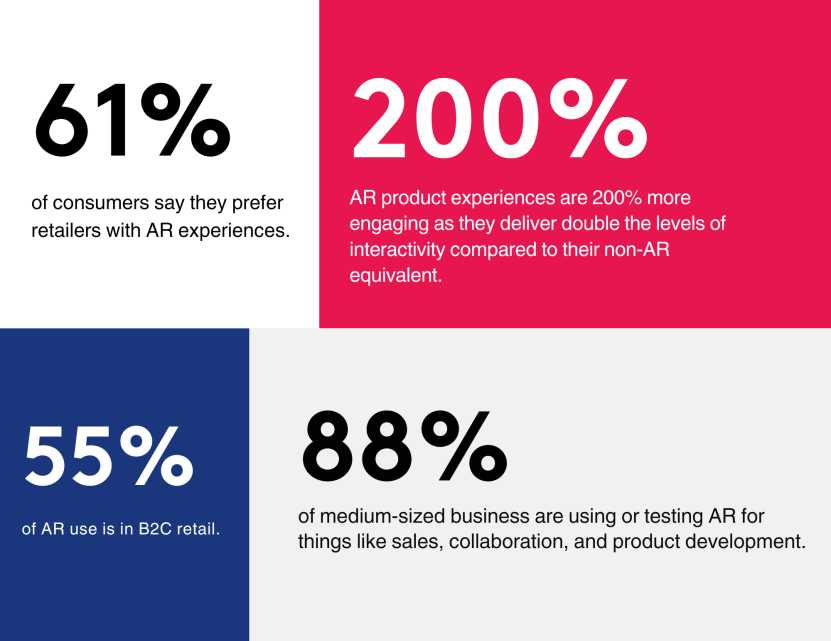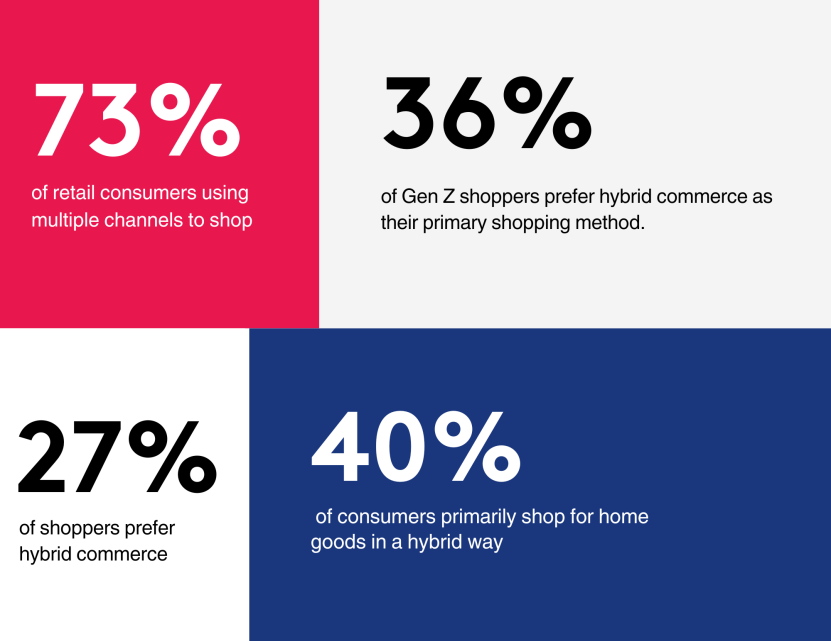eCommerce Trends That Will Dominate 2025

2024 gave us AI and while it is hard to believe, the way we use AI might be its weakest version we will ever have. So if you wrap your head around that, it means that every year going forward will give us even more advanced technology and AI applications.
The world of eCommerce is impacted first hand with these new trends. It is actually entering an exciting new phase. We expect the industry to move fast in 2025, as customers demand more transparency, personalization and overall better digital experiences.
Looking to stay ahead of this dynamic landscape? Let us give you the latest when it comes to eCommerce trends.
In 2025, online businesses will need to invest more in personalization, sustainability, and ecommerce technologies that are future proof to support growth.
NIKE has been at the forefront of customer experience both online and offline. Blending the two worlds even more in their Flagship stores rebranded ”House of Innovation”. With digital displays, mobile integrations and personalization at the customers’ fingertips.
In this article, we’ll explore the future of online shopping, diving into visionary eCommerce strategies. From hyper-personalized shopping to hybrid commerce, these trends will not only drive revenue but also redefine the customer experience.
On this page:
The Rise of Artificial Intelligence in eCommerce
With the launch of OpenAI, Artificial Intelligence (AI) moved from sci-fi movies to being embedded in out everyday world and it become an inherent part of eCommerce technology. it’s impact will keep growing; reshaping the way businesses operate and interact with customers.
In 2025, we expect AI to be integrated in all stages of the customer journey but as well in back office operations such as supply chain and inventory management.
A brand that was able to move fast with AI is definitely Stitch Fix .
Stitch Fix uses large language models from OpenAI and combines it with their own deep learning recommendation algorithms. This integration allows them to interpret customers’ feedback and then use that information to create future recommendations.
The integration of a large language model with proprietary data will be a big trend in 2025 and will give eCommerce business superpowers when it comes to personalization and tailored online experiences.
We will also be seeing a lot more AI-powered chatbots as human-like virtual shopping assistants or after-sale customer service.
These assistants will handle complex customer queries, recommend products based on browsing behavior, and even manage returns and exchanges seamlessly.
AI will spare no branch of eCommerce. Integrating AI with back-end operations will mean more efficiency, better predictions.
Amazon’s AI-driven demand forecasting is a great example of how businesses can analyze purchasing patterns to optimize inventory and pricing dynamically.
The Amazon approach allows them to always have popular products in stock and simultaneously reduce overproduction and waste—an essential practice for sustainable eCommerce.

In marketing, AI tools like predictive analytics allowing businesses to deliver targeted campaigns by analyzing historical data and real-time trends. Who hasn’t enjoyed a good Spotify daylist. Well that is the beauty of Ai in action. The use of AI to ultra-personalize experience will reign over the eCommerce sector in 2025.
Another, more practical use of AI is fraud detection. Platforms like Mastercard Consumer Fraud Risk, Effectiv, Feedzai and Siftare built to help dentify suspicious activities, reducing fraud while ensuring a smooth customer experience.
Businesses that fully embrace AI will not only stay relevant but also redefine what it means to provide exceptional service and personalized shopping experiences, in the competitive eCommerce landscape of 2025.

Embracing Augmented Reality (AR) and Virtual Reality (VR)
Today we can buy pretty much anything online - as amazon says “ everything and the kitchen sink delivered”. When we can sell everything online, finding creative ways for consumers to interact with products online is crucial especially when it comes to items that are deeply rooted in brick and mortar - for example, eyewear or furniture.
This is where Augmented reality shopping and virtual reality in retail are set to revolutionize how customers interact with products online.
These immersive technologies bridge the gap between brick and mortar and eCommerce. It offers customers a way to experience products as if they were physically present.
IKEA’s IKEA Place app is a great example of AR use. Customers can visualize the furniture pieces in their spaces before committing to a purchase. This technology has improved customer satisfaction and reduced returns,
This is not only for furniture. Sephora was one of the early adopters of AR technology with a mobile app that allowed customers to virtually try on makeup.
VR technology in eCommerce is equally transformative even if it is not as democratized as AR. It’s a fun playground for risk taking, big budget brands. It is more about building an innovative reputation than immediate ROI.
In 2025, we hope to see the adoption of VR expand and give us fully virtual stores, where customers can browse aisles, select items, and even engage with virtual sales assistants - exactly as they would in real life.
As eCommerce trends evolve, we will see more and more AR and VR technologies integrated to the customer experience to help deliver personalized shopping experiences.
Sustainable and Ethical Shopping Practices
With recent summer-like winters and oven-like summers, today’s consumers are increasingly eco-conscious and are actively trying to change their consumption habits to reduce their impact on the environment.
Online businesses that put sustainability front and forward will lead the charge in eCommerce in 2025.
From carbon-neutral shipping to ethical sourcing and recycling initiatives, the demand for environmentally friendly practices is reshaping how brands create, sell and operate.
A forever leader in this space is without a doubt Patagonia. It’s a brand that has always been synonymous with sustainability.

Patagonia’s approach to business integrates recycled materials into its products, advocates for environmental activism and even encourages customers to repair rather than replace items through its Worn Wear program.
More platforms are popping up online promoting sustainability and embracing second hand commerce. BackMarket has recently taken the NY subway by storm, with their clever "Downgrade Now" advertising campaign promoting the benefits of buying refurbished tech products.
.png)
In addition to product sustainability, operational transparency is also a key differentiator. Retailers can leverage technologies like blockchain in eCommerce to provide end-to-end traceability, assuring customers of ethical sourcing and manufacturing practices.
Sustainability is increasing in popularity every year and unless we can miraculously reverse climate change, it will undoubtedly be a cornerstone of the future of online shopping.
The Emergence of Hybrid Commerce Models
Hybrid commerce is the brooklyn bridge of businesses. It seamlessly connects online and offline operations blending the convenience of online shopping with in-person store experience.

While supermarkets and big department stores have totally embraced the approach of shopping online and picking-up in store. We will see this practice gain even more popularity as delivery prices are rising.
If anyone remembers, wholefoods delivery used to be free. It is now $9.95 to almost $15 vs a free pick-up in store.
We expect that hybrid commerce will keep expanding to reach all types of industries operating online with physical locations.
The hybrid commerce allows retailers to leverage physical stores as fulfillment hubs. This strategy not only enhances the personalized shopping experience but also aligns with sustainability practices and cutting down on shipping-related emissions.
In 2025, hybrid commerce will continue to be one of the main eCommerce trends. It will require businesses to invest in eCommerce technology that can support hybrid fulfillment and unified data for better visibility across channels.
Hybrid commerce is not just a strategy—it can be an integral part of business sustainability practices and even part of brick and mortar traffic driving strategies
Advanced Data Privacy and Security Measures
In a recent study conducted by statistica, transparency about how companies use personal data ranked number one when it comes to trusting online business. Consumer value their personal data and privacy and they are more likely to give business to brands that are transparent about their data practices.
For this reason, we see data privacy and cyber security take center stage among e-commerce businesses in 2025.
GDPR in Europe has imposed stricter rules on online players to protect personal data, California introduced the CalOPPA, a similar law to protect consumers data and we will not be surprised if more and more countries and states start embracing this approach.
Data privacy in eCommerce will be more than just a compliance requirement—it will be a competitive advantage.
The App Tracking Transparency (ATT) from apple sets new standards for transparency. It gives users the control over their data and what they want share or not share.
Beyond transparency, cyber security in e-commerce is also crucial to build trust and retain customers.
Making sure your online store is built on a secure platform that is PCI compliant with cutting-edge security protocols like end-to-end encryption and multi-factor authentication is critical to safeguard sensitive data.
Putting data privacy and cyber security amongst your priorities in your 2025 e-commerce strategy will help you foster loyalty and ensure long term success.
Modular Code Platforms and Model-Connected Architecture
Technology is constantly evolving and while it is impossible to change e-commerce platforms every year, choosing a composable and scalable platform will allow you to stay agile and adaptable to all new technologies.
Modular code platforms and model-connected architecture, the building blocks of next-generation eCommerce ecosystems.
A modular code platform is a platform that allows businesses to build and scale their digital presence using independent modules or components.
This approach means that each component can be changes and updates without overhauling the entire system.
Model-connected platforms take this concept further by linking every module to a central data model, ensuring real-time synchronization across all touchpoints.
Core dna recently allowed a network of 60 franchisees to be connected within on single eCommerce store. All inventories are synched in real-time between the website and point-of-sale (POS) system while allowing customers to shop multiple inventories in one online order.

This level of connectivity is a game-changer for maintaining consistency and improving operational efficiency.
For businesses, eCommerce platforms like core dna reduce development costs, improve time-to-market for new features, and offer unparalleled flexibility to adapt to evolving eCommerce trends.
The Impact of Voice and Visual Search Technologies
Voice search is becoming the preferred way of searching on mobile for millennials and genz. With 60% of US populations expected to be a mobile shopper by 2026, voice search optimization should be a top priority to stay competitive.
Visual search technology is also gaining ground and fast. With Apple visual intelligence release with iOS18.2 is a testament to the growing adoption of visual search and the importance of visual in the future.
This new feature allows users to identify products in photos or screenshots and find related items instantly, streamlining the path from discovery to purchase.
We expect users to fully adopt these innovations in 2025 and for retailers to optimize their online store SEO for voice search and implement image search to enhance convenience and remain in a competitive eCommerce landscape.
ASOS has recently added visual search tools to its online store. The image search lets shoppers upload images to find similar products, catering to customers who are looking for efficient and precise search results.

Online retailers who adapt to these eCommerce trends will position themselves as leaders in delivering innovative, customer-centric experiences.
Hyper-Personalized Customer Experiences
With AI helping with advanced data analytics, hyper-personalization is made accessible to all e-commerce players. We are not taking just simple other products recommendations. Hyper-personalization in e-commerce is about tailoring the experience to every touchpoint of the customer journey to individual preferences.
For example, an online clothing retailer can tailor the whole online store to the body shape of the online shopper showing products that are sure to fit perfectly rather than having the shopper do the work.
Another great example of hyper-personalization is Spotify Year Wrapped. We all love it, we all anticipate it and the best part is sharing it on social media and refleting on a year of music. A strategy that makes users valued, drives engagement and loyalty.

Netflix’s recommendation engine is another great example of hyper personalization in action. Users are shown mostly shows that they are highly likely to enjoy.
As eCommerce technology advances, businesses will have access to more ai powered tools to help them deliver hyper-relevant experiences.
From dynamic pricing to custom marketing messages, personalization strategies can transform digital experiences and increase conversions.
Social Commerce and Influencer Partnerships
If Social media platforms like TikTok and Instagram have transformed the eCommerce landscape, turning browsing into an interactive shopping experience.
We expect brands to invest in micro-influencers rather than bigger social media account. These accounts usually have between 1000 to 10000 followers but have a larger engagement rate and more active followers.
77% of marketers say what micro-influencers are part of their marketing strategy. This trend is undoubtedly driven by the consumers with 90% of them not trusting influencers.
In 2025, social commerce will continue to dominate but will need to embrace the transparency and sustainability trends we talked about earlier.
Well known brands such as Poppi are already embracing this trend and working with smaller influencers to showcase their drinks in different situations according to the influencer preferences. With fun and colorful packaging, their become an inspiration and drives engagement.
Integrating influencer partnerships and social commerce in your e-commerce strategy will help your brand stay visible, connected, and relevant to its audiences
Adoption of Flexible Payment and Financing Options
The times are hard and inflation is not helping. While we hope 2025 will be a better year for the consumers pockets, we doubt the rise of flexible payment options, such as buy now, pay later (BNPL) will stop.
These solutions, pioneered by companies like Klarna and Affirm, allow shoppers to split payments into manageable installments without the need for credit cards, making high-ticket items more accessible.
Flexible payment systems are now a vital e-commerce strategy to reduce cart abandonment.
Additionally, implementing a simplified checkout process with digital wallets such as Apple Pay and Google Pay or one-click checkouts with platforms like Bolt create frictionless transactions and increase conversions.
As competition continues to be fierce for eCommerce in 2025, integrating diverse payment methods will be essential.

Mastering eCommerce in 2025 will involve being able to be a Swiss Army knife. From AI to sustainability and hyper personalization, the future of online shopping promises to be exiting an challenging.
Online stores will need to be at the forefront of innovation while ensuring they build trust with customers with transparency and sustainable practices.
eCommerce trends will keep evolving but making sure your business is agile and built on scalable platforms is essential to stay competitive and adopt cutting-edge technologies fast.
Agility, foresight, and innovation should be your guiding words for 2025. Businesses that are able to implement these transformative trends and put their customers at the center of their strategies will thrive in 2025.













